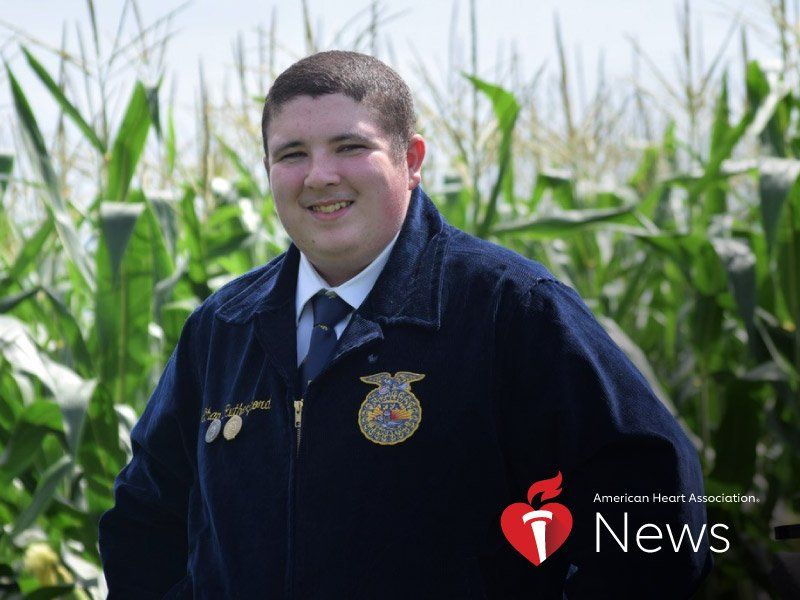
MONDAY, June 12, 2023 (American Heart Association News) — Not long after the snow started falling on a Friday morning in January, Ethan Rutherford went door-to-door in his Wooster, Ohio, neighborhood and offered to shovel snow for the neighbors. The teenager cleared several driveways and sidewalks before returning home.
The snowstorm continued, dumping more than a foot of snow atop the landscape by that Sunday morning back in 2019. Ethan, 14 at the time, wanted to continue helping with snow removal, but he knew it would be easier with a snowblower. There was just one problem: The Rutherfords’ snowblower wasn’t working.
His father, Mark Rutherford, suggested they move the snowblower from the garage to the basement workshop to try getting it running. Soon enough, the father-son team found the problem.
Mark asked Ethan for a wrench. Then Mark saw Ethan go completely stiff. He fell over backward, hitting the back of the workbench and falling under it. Mark grabbed the straps of Ethan’s overalls to pull him out.
Ethan was making a gurgling noise and his skin felt sweaty and clammy; he followed his dad with his eyes but couldn’t communicate. Mark thought his son was having a seizure. He called upstairs for his wife, Erin, to call 911.
Erin Rutherford called dispatch and requested an ambulance. She went back downstairs to check on her son and realized Ethan had no pulse; his skin had turned shades of blue, purple and red. Erin ran back upstairs to call 911 again to tell the dispatcher that Ethan wasn’t breathing and begged them to hurry.
While waiting for the ambulance to arrive, Mark, who learned CPR through a class offered by the local Boy Scout troop, started chest compressions.
Erin ran upstairs to check whether the ambulance was coming, then back down to check on Ethan, then back up again. Wearing only her pajamas – and nothing on her feet – she went outside, in the snow and ice, pounding on the doors of her neighbors in hopes someone could help. Indeed, one man rushed to the Rutherfords’ house and helped clear space in the workshop for paramedics.
When the ambulance arrived, six medics raced down the stairs into the basement and started trying to resuscitate Ethan. They began manual chest compressions and used a defibrillator that shocked Ethan four times before his sinus rhythm was restored and he was stable enough to be transported to the hospital.
Mark and Erin followed the ambulance to the hospital. Erin knew the route well; she used to work there as a patient care assistant.
“He’s in good hands,” one of Erin’s former colleagues told her. “We’re praying for him.”
Doctors said Ethan needed more comprehensive care than the local hospital could provide. They wanted to send him via helicopter to a trauma center in Akron, 35 miles away, but the storm made that impossible. He had to go via ambulance, but that too was a problem because roads were closed. However, there was a way to make this work.
A snowplow crew from the city of Wooster cleared a path to the edge of town. A crew from the next municipality took over from there. And so on, all the way to Akron.
They made it safely, but the slow journey obviously meant a delay in getting Ethan the treatment he needed. In addition to his heart, there were concerns about his brain because of how long he’d gone without oxygen. Erin sensed that the neurologist treating Ethan “didn’t have much hope.”
“We’re not sure what’s going to happen,” he told the Rutherfords.
Ethan was placed in a coma; regular brain scans showed concerning results that doctors attributed to the length of time it took to revive Ethan before he reached the hospital. Three days after he was admitted, brain scans showed signs of improvement. Ethan was brought out of the coma. On the morning of the fourth day, he was conscious and asking questions about what happened. Erin told him, “You almost died.”
Ethan was emotional after learning his heart had stopped, especially when doctors told him that his favorite hobby, go-kart racing, was no longer an option – and rejoining his bowling league or learning to drive might also be prohibited.
Ethan spent two weeks in the hospital. Doctors ran multiple tests but couldn’t find a specific cause for the cardiac arrest.
Ethan received an implantable cardioverter defibrillator, or ICD, a small device that can detect an irregular heartbeat and send a shock to the heart to get the rhythm back to normal in case it ever happened again. Ethan wears a watch with a heart rate monitor to provide added peace of mind.
Although Ethan admits he still worries it might happen again, the 18-year-old is trying to focus on pursuing things that bring him joy. He competed on the varsity bowling team, achieved the rank of Eagle Scout, the highest achievement in scouting, and earned his state degree from the National FFA Organization, the highest degree awarded in a state FFA chapter. In the fall, Ethan will start a diesel mechanics program at a trade school.
“He’s accomplished so much,” Mark said. “Because this has happened, it’s given him the drive to be way more appreciative of just general life.”
Looking back, Ethan credits his faith for where he is today. “For me, it’s a God thing. … Good things come out of it,” he said.
American Heart Association News covers heart and brain health. Not all views expressed in this story reflect the official position of the American Heart Association. Copyright is owned or held by the American Heart Association, Inc., and all rights are reserved.
By Jodi Helmer, American Heart Association News

Leave a Reply